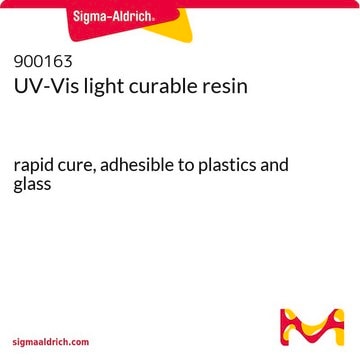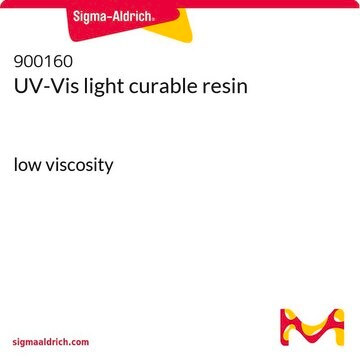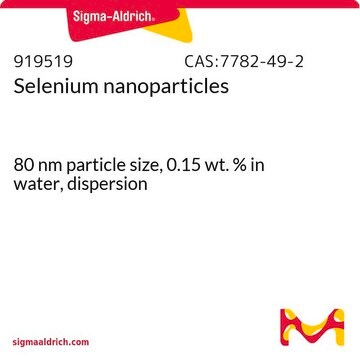925551
Ultracur3D® ST 45
About This Item
Produits recommandés
Caractéristiques du produit alternatif plus écologique
Design for Energy Efficiency
Use of Renewable Feedstocks
Learn more about the Principles of Green Chemistry.
Niveau de qualité
sustainability
Greener Alternative Product
Autre catégorie plus écologique
Description générale
Application
1) Preparation of resin - The material should be processed at room temperature. Before usage the material should be shaken well. Pour it slowly in the vat and wait a couple minutes, until smooth, bubble-free surface is obtained before starting the print job.
2) Printing process - As the suitable 3D printer examples and setting parameters stated above are only for general guidance purpose, user should always define the optimal settings according to nneds and printer.
3) Removing parts - Remove the parts carefully from the build platform with a suite able tool, for more information see the Instruction for Use of the used 3D-printer.
4) Cleaning process - The printed pieces can be cleaned firstly immersing it in glycol ether based solvent in an ultrasonic bath filled with water for 2 minutes, followed by rinsing with 2-propanol for a few seconds. Fine structures or holes may be better cleaned by using 2-propanol and a syringe or by separate brushing. The parts should be placed afterwards in a container filled with fresh 2-propanol and subsequently treated in an ultrasonic bath filled with water for 2 minutes. Blow dry the parts with pressure air/nitrogen, until the parts are clean.
5) Drying - Place the parts into a warming cabinet at 40 °C for 30 minutes.
6) Post-curing - The parts require adequate post curing to achieve the optimized final mechanical properties. After each post-curing cycle, the part needs to be flipped to achieve an even curing.
These proceedings are only general guidelines, the optimal printing settings as well as curing time must be defined by the user himself. The post-curing might differ by using different 3D-Printers and different post-curing units may require different settings.
SLA can be used to create highly complex prototypes with a smooth surface finish. It offers high surface finishing and accuracy, while perfect for printing very large parts.
DLP is your go-to method when opting for a quick printing process without compromising on the quality of intricate parts. It provides high productivity, and can be used for larger and smaller parts.
LCD provides the opportunity to replace low and medium series injection molds with large parts. One of the biggest benefits of printing with Liquid Crystal Display (LCD) is to enable economic and large-scale production.
Testing conditions Ethylene Oxide Sterilization:
- Preconditioning temperature 48 °C
- Preconditioning humidity 60 %
- Preconditioning time 8 hours
- Chamber temperature 45 °C
- Vacuum 75 mbar A
- EO dwell time 3 hours
- EO concentration (calculated) 610 mg/l
- Postconditioning time 48 hours
- Postconditioning temperature 45 °C
The product is designed for fast and accurate additive manufacturing and possesses the following characteristics:
- Viscosity (30C): 210 mPas (cone/plate rheometer)
- Density (liquid resin): 1.12 g/cm3 (ASTM D4052-18a)
- Density (printed part): 1.2 g/cm3 (ASTM D792)
3D printed parts exhibit the following properties:
- E Modulus: 2300 MPa (ASTM D638)
- Tensile Strength: 60 MPa (ASTM D638)
- Elongation at break: 25 % (ASTM D638)
- Impact Strength (notched): 20 J/m (ASTM D256)
- HDT (0.45MPa/1.82MPa): 73C/61C (ASTM D648)
- Hardness Shore: D 88 (ASTM D2240)
Note, these properties may vary based on the 3D printer used, thickness of printed layers, exposure duration per layer, as well as post cure method and its duration.
Stockage et stabilité
Keep container tightly closed in a room temperature (below 30 °C and above 0 °C) and resin away from light. Keep container dry. If Material is not being used fill it back through a filter in the corresponding material bottle. The filter prevents to fill cured pieces or failed prints back into the bottle. Ultracur3D® ST 45 must be disposed of or incinerated in accordance with local regulations.
Informations légales
Mention d'avertissement
Danger
Mentions de danger
Conseils de prudence
Classification des risques
Acute Tox. 4 Oral - Aquatic Chronic 3 - Eye Dam. 1 - Skin Irrit. 2 - Skin Sens. 1 - STOT RE 2 Oral
Code de la classe de stockage
10 - Combustible liquids
Classe de danger pour l'eau (WGK)
WGK 3
Certificats d'analyse (COA)
Recherchez un Certificats d'analyse (COA) en saisissant le numéro de lot du produit. Les numéros de lot figurent sur l'étiquette du produit après les mots "Lot" ou "Batch".
Déjà en possession de ce produit ?
Retrouvez la documentation relative aux produits que vous avez récemment achetés dans la Bibliothèque de documents.
Notre équipe de scientifiques dispose d'une expérience dans tous les secteurs de la recherche, notamment en sciences de la vie, science des matériaux, synthèse chimique, chromatographie, analyse et dans de nombreux autres domaines..
Contacter notre Service technique











